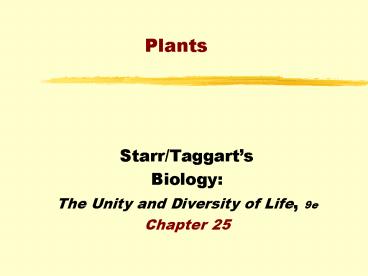Plants - PowerPoint PPT Presentation
1 / 27
Title:
Plants
Description:
Insects Bats Birds. Seed. Ovary. Dicots and Monocots. Almost ... 40 seed per fruit. 8 10 lbs per person. Wheat. Coffee. Sugarcane. in-text, p. 419. HYOCYAMUS ... – PowerPoint PPT presentation
Number of Views:72
Avg rating:3.0/5.0
Title: Plants
1
Plants
- Starr/Taggarts
- Biology
- The Unity and Diversity of Life, 9e
- Chapter 25
2
Filaments of Algae
Ponderosa Pine
Orchids in the rainforest
3
Key Concepts
- The plant kingdom consists mostly of multicelled
photoautotrophs - Almost all plants live on land
- Plants have structural adaptations that allow
them to photosynthesize, absorb water and ions,
and conserve water - Land plants are reproductively adapted to
withstand dry periods
4
Key Concepts
- Seed producers were more successful in radiating
into drier environments based on an evolutionary
scale - Gymnosperms and angiosperms are vascular plants
- Angiosperms include two classes of flowering
plants - Dicots and Monocots
5
FLOWERING PLANTS
?
CONIFERS
CYCADS
PROGYMNOSPERMS
GINKGOS
FERNS
HORSETAILS
ancestral green algae
LYCOPHYTES
RHYNIOPHYTES
BRYOPHYTES
PALEOZOIC
MESOZOIC
CENOZOIC
Silurian
Ordovician
Devonian
Carboniferous
Permian
Triassic
Jurassic
Cretaceous
present
505
435
410
360
290
240
205
138
65
Time (millions of years ago)
Fig. 25.3, p. 405
6
Evolutionary Trends Among Plants
- Photoautotraphs
- Vascular plants
- Roots, stems, leaves
- Gymnosperms
- Seed bearing
- Gingko
- Cycads
- Conifers
- Angiosperms
- Flowers and seeds
- Dicots and Monocots
- Non-vascular plants
- Bryophytes
- Liverworts
- Hornworts
- Mosses
7
Evolution of Roots, Stems, and Leaves
- Roots and Stems
- Below ground
- Shoot systems
- Stems and leaves
- Above Ground
- Sunlight and CO2
- Support of cell wall
- Lignin
- Vascular tissue
- Xylem
- Phloem
- Water conservation
- Cuticle
- Stomata
8
Evolutionary Trend Among Plants
9
Evolution of Pollen and Seeds
- Homospory
- Heterospory
- Pollen grains
- Sperm-bearing gametophytes
- Female gametophytes
- Spread by air, insects, birds
- Seeds
- Embryo of gametophytes
- Nutritive tissues
- Protective coat
10
Bryophytes
- Mosses
- Liverworts
- Hornworts
- Nonvascular
- Moist habitats mostly
- Small
- lt 20 cm tall
- Simplest plants
11
Moss Life Cycle
12
Existing Seedless Vascular Plants
- Whisk ferns, Lycophytes, Horsetails, Ferns
- 3 Differences from Bryophytes
- Sporophyte not attached to a gametophyte
- Has vascular tissues
- Longer phase in life cycle
- Habitat
- Moist places
- Gametophytes lack vascular tissue
- Sperm needs water to reach egg
13
Life Cycle of a Fern
14
The Rise of the Seed-Bearing Plants
- Seed ferns, gymnosperms, angiosperms
- Pollen grains
- Male gametophytes
- Ovules
- Egg producing gametophytes
- Pollination
- Pollen grains arrive on female reproductive
structures - Independent of water for fertilization
15
Spore of A Lycophyte
16
Seed-Bearing Plants
- Depend on
- Pollen grains
- Ovules that mature into seeds
- Tissue changes adapted to dry conditions
17
Gymnosperms- Plants with Naked Seeds
- Conifers, Cycads, Ginkgos, Gnetophytes
- Conifers - cones
- Pines, cypress, firs, spruces, redwoods
Male pine cone
Juniper Cones with berry like looks
18
Female pine at Time of fertilization
Bristlecone pine, Pinus longaeva at the timber
line In the Sierre Nevada.
19
Female, seed bearing cone Largest seed bearing
cones
Male, pollen bearing cone Of the cycad, Zamia
20
Lesser Known Gymnosperms
- Cycads
- Tropical Subtropical areas
- Largest seed-bearing cones
- Zamia in Florida
- Gingko
- Gingko biloba
- Diverse in dinosaur times
- Gnetophytes
- Gneton
- Tropics
- Ephedra
- California
- Welwitschia mirabilis
- Deserts in Africa
21
Pollen bearing Cones
Fleshy coated seed
Ginkgo biloba
Fig. 25.14, p. 413
22
AngiospermsThe Flowering Seed-Bearing Plants
- Flowers
- Coevolution with pollinators
- Insects Bats Birds
- Seed
- Ovary
23
Dicots and Monocots
- Almost 180,000 Dicots are herbaceous
- Cabbage and Daisies
- Flowering shrubs and trees
- Water lilies
- Cacti
- About 80,000 Monocots
- Orchids, palms, grasses, crop plants, rice
24
Theobroma cacao 40 seed per fruit 8 10 lbs per
person
Coffee
Wheat
Fig. 25.20, p. 418
Sugarcane
25
DIGITALIS PURPUREA
NICOTIANA RUSTICUM
ATROPA BELLADONNA
CANNABIS SATIVA
in-text, p. 419
HYOCYAMUS
26
In Conclusion
- Plants probably arose from green algae
- Trends in evolution can be identified by
comparing structural adaptations to dry
conditions, shifts to diploid dominance, and the
shift to heterospory - Bryophytes are nonvascular plants and require
free water for fertilization - Vascular plants are adapted to life on land
27
In Conclusion
- Gymnosperms are vascular plants that produce
pollen grains and seeds - Ovules contain the egg-producing female
gametophytes - Evolution of pollen grains freed these plants
from dependence on water for fertilization - Angiosperms produce flowers and coevolved with
pollinators - developed by M. Roig

